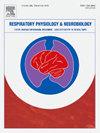吸气负荷时,先前自我控制努力对呼吸努力的影响
IF 1.6
4区 医学
Q3 PHYSIOLOGY
引用次数: 0
摘要
自我控制反映了对注意力、行为和情绪冲动的努力抑制,以达到预期的长期目标。先前的自我控制运动不会影响空气饥饿和对进行性高碳酸血症的耐受性,但它是否会影响机械上不同的呼吸努力感仍然未知。方法14名健康年轻人(13名男性,1名女性)最初完成了3项熟悉试验,其中包括增量吸气压力阈值负荷(IPTL)试验,该试验从10 cmH2O负荷开始,随后每分钟增加10 cmH2O直到任务失败。之后,参与者完成了三个实验,包括IPTL前休息(Control; CTRL)、不需要自我控制的一致性Stroop任务(CONG)和需要自我控制的不一致性Stroop任务(INCONG)。在每次阈值负荷结束时测量呼吸努力。ResultsTime任务失败在IPTL 13 %短INCONG(8.60 ±1.69 min)比CTRL(9.96 ±1.79 min)和CONG(9.87 ±1.57 min) (P & lt; 0.001)。最大可持续阈值压力持续整整1 分钟低INCONG(84 ± 19 cmH2O)比CTRL(96 ± 18 cmH2O)和CONG(99 ± cmH2O 17日)(P & lt; 0.001)。在IPTL期间,INCONG组的呼吸努力增加率(0.14 ± 0.03 a.u /cmH2O)高于CTRL组(0.12 ± 0.03 a.u)/cmH2O) (P = 0.016)和CONG(0.12 ± 0.03 )/ cmH2O) (P = 0.014)。结论先前的自我控制运动增加了后续IPTL中呼吸力竭感,减少了任务失败时间。这些发现表明,呼吸努力的感觉是由状态自我控制调节的。本文章由计算机程序翻译,如有差异,请以英文原文为准。
Effects of prior self-control exertion on breathing effort during inspiratory loading
Introduction
Self-control reflects the effortful inhibition of attentional, behavioural, and emotional impulses to achieve a desired long-term goal. Prior self-control exertion does not affect air hunger and tolerance to progressive hypercapnia, but whether it affects the mechanistically distinct sense of breathing effort remains unknown.
Methods
Fourteen healthy young adults (13 males, 1 female) initially completed three familiarisation trials comprising an incremental inspiratory pressure-threshold loading (IPTL) test, which began at a load of 10 cmH2O followed by a 10 cmH2O increase every minute until task failure. Thereafter, participants completed three experimental trials comprising IPTL preceded by rest (Control; CTRL), a congruent Stroop task (CONG) requiring no self-control exertion, or an incongruent Stroop task (INCONG) requiring self-control exertion. Breathing effort was measured at the end of each threshold load.
Results
Time to task failure during IPTL was 13 % shorter in INCONG (8.60 ± 1.69 min) than CTRL (9.96 ± 1.79 min) and CONG (9.87 ± 1.57 min) (P < 0.001). The maximum sustainable threshold pressure sustained for a full 1 min was lower in INCONG (84 ± 19 cmH2O) than CTRL (96 ± 18 cmH2O) and CONG (99 ± 17 cmH2O) (P < 0.001). The rate of increase in breathing effort during IPTL was greater in INCONG (0.14 ± 0.03 A.U./cmH2O) than CTRL (0.12 ± 0.03 A.U./cmH2O) (P = 0.016) and CONG (0.12 ± 0.03 A.U./cmH2O) (P = 0.014).
Conclusion
Prior self-control exertion increased the sense of breathing effort and reduced time to task failure during subsequent IPTL. These findings suggest that the sense of breathing effort is modulated by state self-control.
求助全文
通过发布文献求助,成功后即可免费获取论文全文。
去求助
来源期刊
CiteScore
4.80
自引率
8.70%
发文量
104
审稿时长
54 days
期刊介绍:
Respiratory Physiology & Neurobiology (RESPNB) publishes original articles and invited reviews concerning physiology and pathophysiology of respiration in its broadest sense.
Although a special focus is on topics in neurobiology, high quality papers in respiratory molecular and cellular biology are also welcome, as are high-quality papers in traditional areas, such as:
-Mechanics of breathing-
Gas exchange and acid-base balance-
Respiration at rest and exercise-
Respiration in unusual conditions, like high or low pressure or changes of temperature, low ambient oxygen-
Embryonic and adult respiration-
Comparative respiratory physiology.
Papers on clinical aspects, original methods, as well as theoretical papers are also considered as long as they foster the understanding of respiratory physiology and pathophysiology.

 求助内容:
求助内容: 应助结果提醒方式:
应助结果提醒方式:


